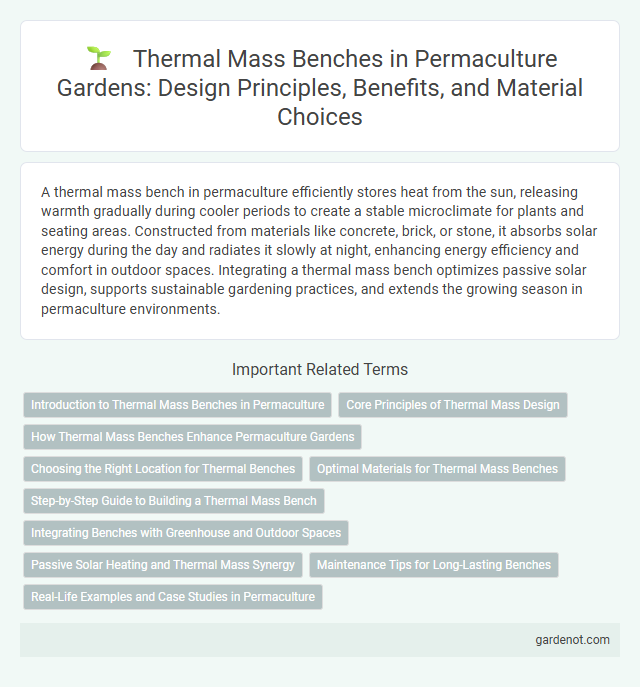A thermal mass bench in permaculture efficiently stores heat from the sun, releasing warmth gradually during cooler periods to create a stable microclimate for plants and seating areas. Constructed from materials like concrete, brick, or stone, it absorbs solar energy during the day and radiates it slowly at night, enhancing energy efficiency and comfort in outdoor spaces. Integrating a thermal mass bench optimizes passive solar design, supports sustainable gardening practices, and extends the growing season in permaculture environments.
Introduction to Thermal Mass Benches in Permaculture
Thermal mass benches in permaculture harness materials like stone, concrete, or earth to absorb, store, and gradually release heat, regulating microclimates year-round. These benches optimize passive solar energy, improving plant growth and extending growing seasons in food forests and garden zones. Integrating thermal mass benches enhances energy efficiency and supports sustainable design by reducing reliance on artificial heating.
Core Principles of Thermal Mass Design
Thermal mass bench design in permaculture centers on maximizing heat absorption, storage, and gradual release to regulate microclimates effectively. Key principles include selecting dense materials like concrete or stone that retain heat, orienting the bench to capture sunlight during winter, and incorporating insulation to minimize heat loss. Properly implemented thermal mass benches enhance energy efficiency and create comfortable outdoor spaces by stabilizing temperature fluctuations.
How Thermal Mass Benches Enhance Permaculture Gardens
Thermal mass benches store heat during the day and release it slowly at night, creating a microclimate that extends the growing season in permaculture gardens. Their ability to moderate temperature fluctuations supports plant health and boosts productivity by protecting sensitive crops from cold stress. Integrating materials like stone or concrete, these benches optimize energy use and improve garden sustainability through natural heat regulation.
Choosing the Right Location for Thermal Benches
Selecting the optimal location for a thermal mass bench involves placing it where it can absorb maximum sunlight, typically along sun-facing walls or in areas with unobstructed solar access. Positioning the bench near exterior walls made of brick, stone, or concrete enhances heat retention and radiates warmth efficiently during cooler periods. Avoiding shaded spots and considering local climate patterns ensures the thermal bench functions effectively within a permaculture design to regulate temperature naturally.
Optimal Materials for Thermal Mass Benches
Optimal materials for thermal mass benches include concrete, brick, and stone due to their high heat capacity and ability to store and slowly release thermal energy. These materials efficiently absorb heat during the day and provide warmth during cooler periods, enhancing passive solar design in permaculture settings. Incorporating recycled or locally sourced materials can improve sustainability while maintaining thermal performance.
Step-by-Step Guide to Building a Thermal Mass Bench
Building a thermal mass bench begins by selecting dense materials like concrete or stone to store and release heat efficiently. Construct a sturdy frame, then arrange and secure the thermal mass units with insulating layers to maximize heat retention. Finish with a weather-resistant surface and position the bench where it can absorb sunlight for passive heating in permaculture designs.
Integrating Benches with Greenhouse and Outdoor Spaces
Thermal mass benches in permaculture maximize heat retention by absorbing and slowly releasing solar energy, creating microclimates that promote plant growth in greenhouses and outdoor environments. These benches, often constructed with materials like concrete or stone, are designed to regulate temperature fluctuations and enhance energy efficiency within integrated permaculture systems. Incorporating thermal mass benches into greenhouse layouts and garden seating areas fosters sustainable warming while supporting diverse plant habitats and human comfort.
Passive Solar Heating and Thermal Mass Synergy
Thermal mass benches enhance passive solar heating by absorbing sunlight during the day and slowly releasing stored heat into living spaces, promoting energy efficiency and thermal comfort. The synergy between thermal mass materials like concrete or stone and strategic bench placement maximizes heat retention and distribution, reducing reliance on conventional heating. Incorporating these benches in permaculture designs supports sustainable microclimates and extends growing seasons by stabilizing indoor temperatures naturally.
Maintenance Tips for Long-Lasting Benches
Thermal mass benches require regular inspection to ensure cracks and erosion from weather exposure are promptly repaired, preserving their heat retention capabilities. Applying a protective sealant annually helps prevent moisture infiltration and prolongs the bench's structural integrity. Clearing debris and organic matter from the bench surface minimizes mold growth and enhances durability in permaculture garden settings.
Real-Life Examples and Case Studies in Permaculture
Thermal mass benches in permaculture designs leverage materials like rammed earth, concrete, or stone to store heat during the day and release it at night, exemplified by Geoff Lawton's Zaytuna Farm where such benches significantly extend growing seasons. In the Mediterranean permaculture project at La Cueva del Agua, thermal mass benches under south-facing glass capture solar energy, creating microclimates that support diverse plant species. Case studies in temperate zones reveal that incorporating thermal mass benches in keyhole garden layouts boosts plant resilience by stabilizing temperature fluctuations effectively.
Thermal mass bench Infographic

 gardenot.com
gardenot.com